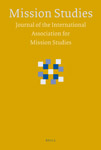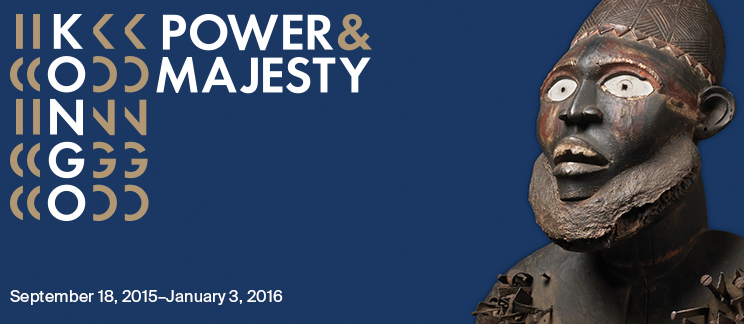Reviews
As researchers, we review the work of other scholars not related to CGCM. Sometimes those reviews are published in journals; sometimes they will be published here for the first time. Notice of publication or the reviews themselves will be posted here.
Women and Christian Mission
Laura A. Chevalier, PhD candidate and CGCM student affiliate, has reviewed an important book exploring women and missions, Women and Christian Mission: Ways of Knowing and Doing Theology by Frances S. Adeney. Her review can be found in Missiology: An International Review 44, No.3 (July 2016): 362.
Biographer’s Craft
The Dictionary of African Christian Biography was recently highlighted by the Biographer's Craft, a monthly newsletter for writers and readers of biography. The article was written by Kathleen Sheldon who participated in the African Christian Biography Conference held at Boston University, October 29-31, 2015.
|
|
Kongo: Power and Majesty
Review by Cathy Corman, CGCM Visiting Researcher
Those interested in the history of African Christianity may want to consider making a trip to The Metropolitan Museum of Art before January 3, 2016, to tour Kongo: Power & Majesty. The exhibit focuses on the material culture of Central African peoples after contact with Portuguese Catholics in the late fifteenth century. Curators have done a terrific job showcasing the ways master craftspeople wove tapestries and caps, incorporated crucifixes into indigenous forms, carved female power figures to increase fertility during population decimation, and crafted male power figures to safeguard villages struggling to survive. It’s well worth paying $7 for the audio guide, which weaves together interesting background information and curators’ interesting analyses. The Met is also featuring two relevant photographic exhibits in its contemporary collection: In and Out of the Studio: Photographic Portraits from West Africa and The Aftermath of Conflict: Jo Ratcliffe’s Photographs of Angola and South Africa.
The Making of Korean Christianity
 The award winning book, The Making of Korean Christianity: Protestant Encounters with Korean Religions, 1879-1915 was recently reviewed in the Africanas Journal. The publication is doubly significant for the Center for Global Christianity & Mission, as the author of the book, Sung-Deuk Oak, graduated from the Boston University School of Theology in 2002. The review was written by Gun Cheol Kim, a current PhD candidate in Mission Studies at the School of Theology.
The award winning book, The Making of Korean Christianity: Protestant Encounters with Korean Religions, 1879-1915 was recently reviewed in the Africanas Journal. The publication is doubly significant for the Center for Global Christianity & Mission, as the author of the book, Sung-Deuk Oak, graduated from the Boston University School of Theology in 2002. The review was written by Gun Cheol Kim, a current PhD candidate in Mission Studies at the School of Theology.
Evaluating the East African Revival
 Daewon Moon, who is currently studying the East African revival in Burundi, reviewed Kevin Ward and Emma Wild Wood's The East African revival: History and Legacies in the journal Mission Studies.
Daewon Moon, who is currently studying the East African revival in Burundi, reviewed Kevin Ward and Emma Wild Wood's The East African revival: History and Legacies in the journal Mission Studies.
Chris James’ review of Perspectives on Ecclesiology and Ethnography
 Doctoral student Christopher James has recently reviewed a book on the intersection of ecclesiology and anthropology, Perspectives on Ecclesiology and Ethnography, edited by Pete Ward. Check out the review in Missiology: An International Review 42 (1), January 2014, 92-93.
Doctoral student Christopher James has recently reviewed a book on the intersection of ecclesiology and anthropology, Perspectives on Ecclesiology and Ethnography, edited by Pete Ward. Check out the review in Missiology: An International Review 42 (1), January 2014, 92-93.
Cathy Corman on Hollinger’s “After Cloven Tongues of Fire”
UC Berkeley history professor emeritus David Hollinger describes in After Cloven Tongues of Fire his encounter with an essay of sinologist Joseph R. Levenson. “This essay,” Hollinger writes, “helped me formulate […] the chief questions on which I have worked for forty years. Levenson came at the right time for me” (164).
Here’s what I wrote in the margins: “Hollinger came at the right time for me.”
In a preface, ten chapters, and an epilogue, Hollinger explores the long-shadow liberal Protestants have cast on American politics and scholarship. He digs into the work of William James and Reinhold Niebuhr and is particularly interested in the relationship between pragmatism, the Enlightenment, science, and Christianity. Hollinger writes about the significance of a variety of gatherings, from the Realist-Pacifist Summit at Ohio Wesleyan University in 1942 to the Lilly Seminar, a twenty-first-century conference convening scholars for three years to debate the role of Christianity in American universities. One particularly sparkling essay treats the concept of “post-religion” in the context of American Jewish history. But for me Hollinger’s most important chapters showcase his thoughts on the rise and fall of mainline Protestantism, especially regarding social gospel and foreign missions.
The title of Hollinger’s collection, After Cloven Tongues of Fire, refers to the biblical story of Pentecost in Acts 2:1-11. These verses describe tribes with different linguistic backgrounds able to testify in a common language --“cloven tongues of fire.” To experience the divine and communicate across boundaries, even for a brief moment, is a miracle. The question, Hollinger asks, is what happens after: “What does one do in the world, in the prosaic routines of daily life, to act on this vision of human community inspired by the Jesus of Nazareth?” (x-xi).
Hollinger believes the answer to this question defines the split between two strands of American Protestantism in the twentieth century: evangelism and ecumenism. Some Protestants focused on ecstatic, mystical experience and believers’ relationships to the Divine. Hollinger identifies these Christians as “evangelicals.” They became “scripture-centered activists” (xiii) who worked to recreate “the spiritual intensity of the moment” (22). The “ecumenists,” meanwhile, explored what happened next, after the mystical moment, which led them to be “more frankly concerned with social welfare than with the state of the individual soul” (22). These Christians, cosmopolitan modernizers and energetic institution builders, “sought to overcome the curse of Babel not in fleeting moments of ecstasy but in the prosaic routines of daily life” (22).
Hollinger’s framework crystallizes what I have come to know about the evangelical/ecumenical split through Barry Alter, the Presbyterian missionary whose voice animates my project, “In the Midst.” Like the ecumenists Hollinger studies, Alter’s religious activism centered on the World Council of Churches, the Fellowship of Reconciliation, both the YM and YWCAs, and the periodical The Christian Century. Unlike Hollinger’s ecumenists, Alter’s spiritual home was Yale Divinity School, not Union Theological Seminary in New York, although that institution certainly played a large role in her life. Steeped in “social gospel” from childhood, Alter, along with other mainline Protestants, came to embrace pacifism, racial and gender equality, contraception, and the validity of same-sex relationships.
Hollinger’s explorations of ecumenist missionaries’ decisions to “engage the world rather than withdraw from it” jibe with the stories that make up “In the Midst.” Christian liberals, Hollinger writes, “were in the process of changing the notion of ‘foreign missions’ to one of ‘world mission,’ with the implication that indigenous peoples were no less qualified to preach and exemplify the gospel than Methodists and Presbyterians from the United States” (72). Reading that passage, I immediately summoned Alter’s growing conviction in the 1940s at Connecticut College that she would not serve as a foreign missionary unless she could rid herself of feelings of cultural superiority and American exceptionalism. Hollinger identifies missionaries, like Alter, who looked fondly on “foreign peoples” and their “inherited religions” (11). As these missionaries came to know those they served overseas, they concluded, like Alter, that “the Hindus and Buddhists they encountered […] were not quite so much in need of Christian conversion as once assumed” (44).
Hollinger’s conclusion, that the ecumenists’ success in some ways foretold their decline, resonates with what I know of Alter’s life, as well. Because they used contraception (as did Alter and her husband), ecumenist women gave birth to fewer children than evangelicals. Their numbers – relative to evangelicals – declined. More important than this fact of demography, Hollinger explains, ecumenists’ children embraced their parents’ tolerance for a multiplicity of beliefs but chose not to join their parents’ churches. This observation holds true for two of Alter’s three children. While one of her kids, John, is currently teaching English and serving as chaplain at a liberal, private Episcopal school, the other two have not affiliated with any denominations or churches. Marty, Alter’s daughter, has spearheaded a movement to organize marginalized women workers around the globe. Tom, Alter’s youngest son, took Indian citizenship and, through his work as a celebrated film and stage actor, champions the preservation of India’s wild places. I won’t touch, here, on Alter’s nephews or grandkids, many of whom are equally committed to issues of social and environmental justice here and abroad.
I was motivated to record Alter’s life stories in large part because of her deep-seated disappointment in her country’s refusal to acknowledge her cohort’s commitment to Christianity and its influence on important political shifts, from Abolition to Civil Rights. Hollinger tackles America’s cultural amnesia head on. Were it not for the Christian work of oft-overlooked liberalizers, Hollinger argues, America would not be home to the pluralistic, multi-cultural society we enjoy today. Ecumenists like Barry Alter “play a greater role in American history than is commonly recognized,” he writes, and therefore deserve “attention” and recognition (xi).
I feel lucky to have encountered Hollinger’s essay collection now, as I’m working to finish “In the Midst,” because it fuels my afterburners. I started this project out of love and conviction. I’m going to finish this project, because of Hollinger’s superb overview, with a greater appreciation for its historical significance.
See: David A. Hollinger, After Cloven Tongues of Fire: Protestant Liberalism in Modern American History (Princeton and Oxford: Princeton University Press, 2013).
Ted Karpf recommends “The One Mind”
Is there hope for the future? Our future? And the future of faith? Dr. Larry Dossey plots a direct course that takes us there NOW filled with love and possibility. Amidst the cacophony of doomsayers about the future of religion, faith, spirituality, The One Mind is our personal invitation to discover that to which everyone is pointing but not naming. In this bold initiative he raises the bar; documenting the research and preponderance of data, evidence, history, tradition and mythology, which is the sum and substance of the human experience. Simply there is one Mind. The One Mind is a compelling page-turner with an “aha” at the end of every chapter, leaving readers to wonder, “why do we doubt our experience at all?” While some Christians may be worried that Dossey, who stands outside the tradition, is bordering on heresy, Gnosticism, or some New Age wonderment, the fact is he is pointing to the “one” to whom people of faith have pointed, worshiped and adored for ages upon ages. What he has done is walked us headlong into the 21st century and challenged our metaphors and assumptions, and opened a door through which each of us may go as a faithful sojourner and pilgrim.This book is an invaluable tool which re-affirms our knowing and demonstrates again and again, that no one of us is really alone!
Review of “Theology for the Global Church”
Student Travis Myers has reviewed a noteworthy book exploring theology and missiology, Local Theology for the Global Church: Principles for an Evangelical Approach to Contextualization. His review can be found in Missiology: An International Review 39, no. 3 (July 2011): 413-414.
